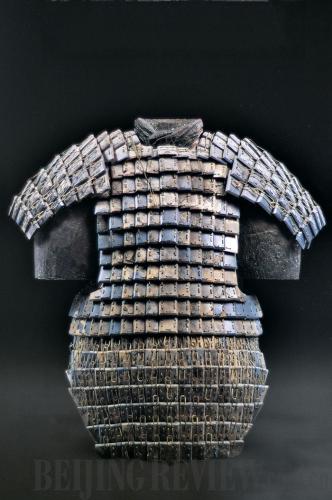|
 |
|
IN GOOD SHAPE: Stone armor restored by archeologists. In its completed form, it shows the exquisite craftsmanship of the Qin Dynasty's artisans (FILE) |
The Mausoleum of Emperor Qin Shihuang (259-210 B.C.), the location of the famous Terracotta Warriors, is regarded as the largest and most complicated underground tomb in the world. At the time of its construction, Qin's tomb was unprecedented in its magnificence and grandeur, a fitting resting place for China's first and most powerful conqueror.
Just before his death, Emperor Qin ordered the creation of an army that he could take with him into the afterlife to make him just as powerful there as he was in the corporeal world.
After more than 10 years of hard work, Chinese archeologists have restored some of the stone armor that was retrieved from a burial pit near the mausoleum, which sheds further light on the military prowess of Qin's near-invincible army.
The burial pit, known by its designated code K9801, was first discovered in 1998. Archeologists have since found 87 pieces of stone armor and 43 stone helmets from the 145 square meters excavated so far. They were originally made out of multiple pieces of stone that were woven together using copper wire.
Zhang Weixing, deputy director of the archeology department at the mausoleum, said, "Pit K9801 covers an area of 130,000 square meters. Completed excavation shows that the pit might have been an arsenal for Qin's underground army."
The stone armor his team uncovered are invaluable for archaeologists researching ancient Chinese military capabilities, according to Zhang. The stone armor is made up of hundreds of small pieces linked together like fish scales. Previously, historians had thought that scaled armor was not in use until the later Han Dynasty (202 B.C. - A.D. 220). Furthermore, such armor would have belonged to high-ranking officials as the time and effort needed to create it would not have been wasted on foot soldiers.
"The excavated armor provides an example of the excellent craftsmanship and artistic style from the time. But they would not have been for combat," Zhang added.
In 2002, the renowned archeologist and former director of the mausoleum Yuan Zhongyi suggested that the uncovered relics were probably models created especially for burial use.
Under today's understanding, ancient China's armor in the period before the Qin Dynasty (221-207 B.C.) was leather based. At that time, metal would have been a scarce resource. Bronze was mainly used to make weapons rather than armor. The unearthed armor appears to be models of the leather armor that would have been in use at the time. Yuan also assumes that the armor belonged to Emperor Qin's household troops, the soldiers tasked with escorting and protecting Qin himself.
However, archeologists still don't know how the stone armor was made or who it was made by. Despite the many mysteries, the armor provides invaluable material for archeologists to research the Qin Dynasty's military technology. What's more, the discovery of a stockpile of stone armor buried together answers why the famous Terracotta Warriors and horses of Emperor Qin Shihuang's Mausoleum, which were first discovered in 1974, were found without weapons or armor on them.
Since the discovery of pit K9801, archeologists have made efforts to repair the stone armor in order to answer the multitude of questions they have about the Qin Dynasty's technology. According to the latest findings, a suit of stone armor consists of 600 individual parts. Archeologists say that if a craftsman worked for eight hours a day, it would take 344 days, nearly a year, to complete just one suit of stone armor. It is estimated that pit K9801 contains over 5 million stone pieces in total. This indicates a massive undertaking by a large number of craftsmen.
On top of this, the question of where the Qin Dynasty acquired the stone for making the burial armor was not solved until 2004. After field investigations and research, archeologists working at the mausoleum concluded that the stone materials were carried from North Mountain in Fuping County, in northwest China's Shaanxi Province. In fact, the history book Shi Ji (Records of the Grand Historian) written by Sima Qian (145-87 B.C.) recorded that the stone materials were taken from North Mountain.
By recovering the stone armor, archeologists discovered that Qin's soldiers would have been well protected during combat. The stone armor covered nearly all of the body and the head of the soldier wearing it. Furthermore, the scaled armor allowed soldiers a higher degree of maneuverability. The armor protecting the joints has enough clearance for movement, allowing soldiers to fight without restriction. At present, archeologists have assembled some of the stone armor for public exhibition in near future.
Located in east Xi'an, the capital of Shaanxi Province, Qin's mausoleum covers an area as large as 60 square kilometers. The main tomb is surrounded by hundreds of pits in which the world famous Terracotta Warriors and other artifacts were buried to protect the emperor in the afterlife.
Email us at: baishi@bjreview.com | 